
The Russians lick their wounds, repairing damaged buildings and walls, as well as generating new Strelets, Oprichniks, and Cossacks to replace the lost ones. They’re sure to appeal to Ivan the Terrible in their Home City, Moscow, for shipments of resources that will let them create those military units faster. Luckily for them, the British foray did little to damage their economy, enabling their settlers to resume producing wood, food, and coins.
In many ways, the action swirling around us seems very similar to Age of Empires II — gather resources, construct buildings, create military and economic units, and plan offensive and defensive strategies. However, the third entry in this popular real-time strategy series brings with it some exciting new developments, including Home Cities, trade routes, and the ability to forge crucial alliances with Native Americans, whose settlements lie scattered around each map.
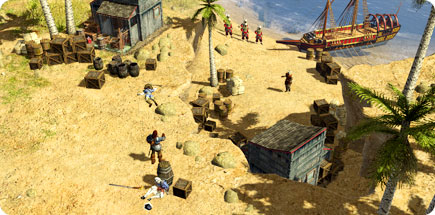
We Are the Knights of St. John. Trading barbs with the Ottoman leader, Sahin.
Adding an RPG Vibe
“The Home City feature was the main vehicle we used to change up the gameplay every single game,” explains lead designer Greg Street. He watches a group of Cossacks charge out of a nearby stable before continuing. “It grows and changes over time, so a player has options in her second game that weren’t in the first one, and so on. A lot of gamers like improving their character in a role-playing game (RPG), and the Home City adds a little bit of that vibe to the real-time strategy genre.”
As a match progresses, you accumulate points that you redeem by visiting your Home City, where you can trade them for cards that represent troops, resources, and other necessities. You also earn experience points — another idea borrowed from the RPG world, and one that allows you to unlock new cards between matches. You can only have a certain number of cards in your Home City “deck” during each match, which means you should stack it with cards beneficial to the type of match you’re playing next.
“The Home City adds a little bit of that [RPG] vibe to the real-time strategy genre.”
- Greg Street, lead designer
You can also customize your Home City with various visual elements. For example, you can add banners to your military academy, or place a street preacher outside your cathedral. You might add a fisherman to your harbor, or even unlock a feature that lets you see what your citizens are saying as they stroll through the Home City. None of those elements change the resources available to you during a match, but you’ll still enjoy putting your own mark on London, Moscow, Paris, or any of the other Home Cities in the game.
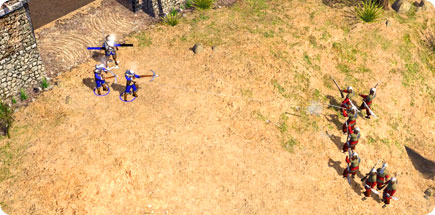
Enemy at the Gates. Guarding a fortress from an Ottoman attack during one of the single-player campaigns.
“Even if you lose a game,” Street notes, “you can still benefit from it by improving your Home City. I’m really happy with the way this feature has been received, and I wouldn’t be surprised if it starts showing up in a lot of strategy games in the future.”
Experience 350 Years of History
When asked why his team added the Home City feature, Street replies: “It fit this time period. It didn’t make sense to say: ‘It’s 1640. You are the leader of the mighty French empire, which, by the way, consists of three people, one building, and a goat.’ But if you portray that this is just a colony for the French, and that the success of your colony can bring wealth and power back to Paris, and vice-versa, it just made sense.”
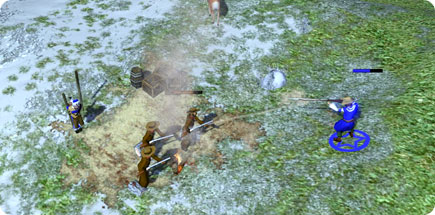
Make New Friends. Free this French settler from these treasure guardians and he will join you.
The time period of Age of Empires III is 1500 to 1850, and the setting is North and South America, where eight nations — Spain, Britain, France, Portugal, Holland, Russia, Germany, and the Ottoman Empire — vie for control of the New World. The ability to erect outposts along pre-existing trade routes, as well as the chance to become friendly with nearby Native American settlements, offer new ways to boost resource accumulation.
Game Hardware
Check out our systems for your best gaming experience.
- Site: Age of Empires III
- Publisher: MacSoft
- Developer: Ensemble Studios
- Genre: Strategy
Game Media
“So many games have a dark and post-industrial look, which we think is turning off many gamers. The sun is always shining in Age of Empires.”
- Greg Street, lead designer
Treasures scattered around each map also provide free resources, should your explorer be the first to find them. Watch out for the people and animals who guard those finds, however.
The single-player campaign opens in the late 16th century as the Knights of St. John defend their stronghold on Malta from an Ottoman invasion. The story puts you in control of the Knights as they repel increasingly desperate Ottoman offensives, despite the attackers’ manpower advantage. After those victories, you make your way to the New World, where an Ottoman leader, Sahin, is one step ahead of you in the search for a secret Aztec lake that holds the key to immortality. The 24 missions in the campaign span three generations of the fictional Black family, members of the Knights of St. John, and their adventures in the Americas.
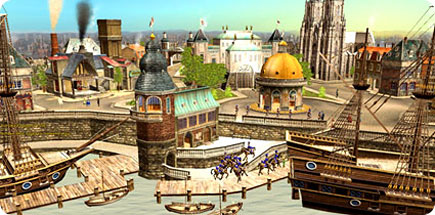
We’re Off to See the Colony. Reinforcements board a ship docked at a Home City.
“To many people,” Street explains as we watch a large contingent of Russian troops move out to attack the British, “the Age of Empires III time period conjures up images of powdered wigs and silly hats. We tried to emphasize cool things, like pirates, Native Americans, and lots of explosions.”
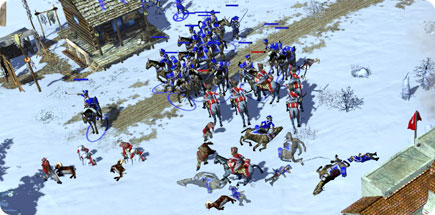
Volleys in the Snow. Opposing forces trade blows.
The Sun is Always Shining
Explosions are a big part of Age of Empires III’s look, which takes the series into 3D graphics for the first time. New techniques allow water to move realistically and accurately reflect objects in or near it, while buildings burst into flame and crumble during an enemy bombardment. New geometric features enabled Street’s team to create the realistic overhangs and steep cliffs found in places like the American Southwest.
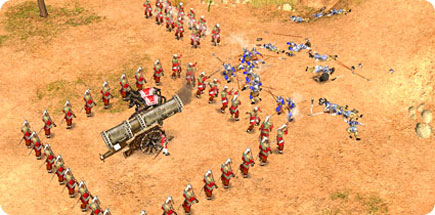
Try Out New Ideas. Order groups of units into different battle formations.
“This emphasis on visuals is something we learned while developing Age of Mythology,” Street points out. “That game allowed us to add some over-the-top eye candy, like meteors and monstrous units. We spent a lot of time on things like artillery firing and ship destructions in Age of Empires III in order to add similar visual interest.”
He adds: “So many games have a dark and post-industrial look, which we think is turning off many gamers. The sun is always shining in Age of Empires.”



